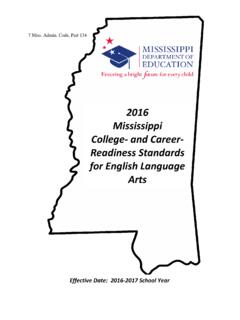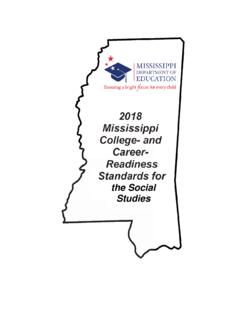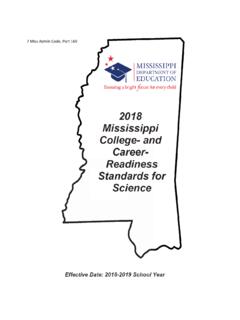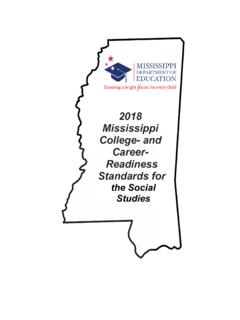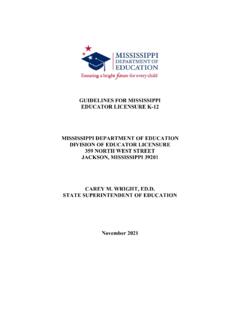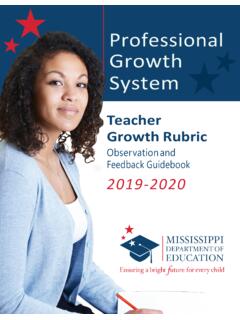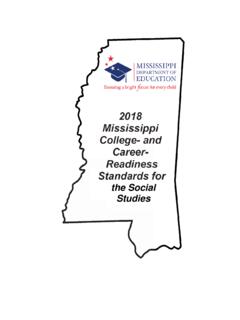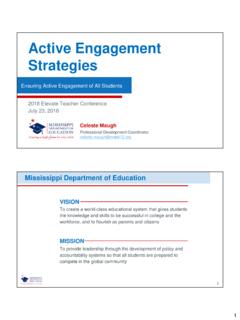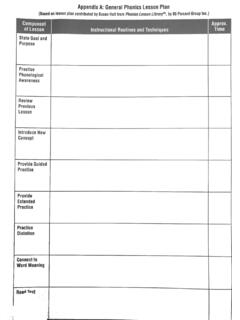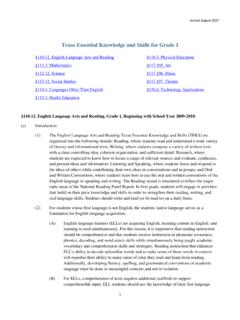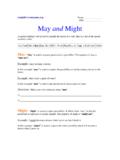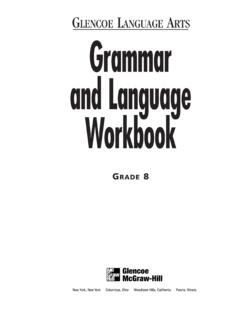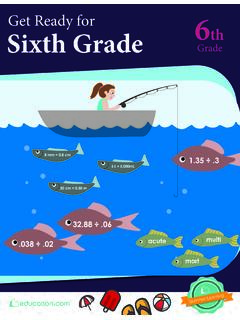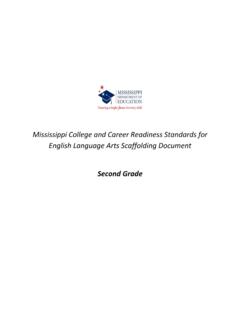Transcription of Mississippi College and Career Readiness Standards for ...
1 Mississippi College and Career Readiness Standards for English Language Arts Scaffolding Document Third grade College - and Career - Readiness Standards for English Language Arts Page 2 of 99-September 2016 Third grade : Read closely to determine what the text says explicitly and to make logical inferences from it; cite specific textual evidence when writing or speaking to support conclusions drawn from the text. Ask and answer questions to demonstrate understanding of a text, referring explicitly to the text as the basis for the answers. Desired Student Performance A student should know (Prerequisite Knowledge) Readers ask questions before, during, and after reading.
2 Readers answer questions (who, what, when, where, why, and how) about specific details from the text. Authors of literature include characters, a setting, and major events. Readers visualize key elements within the text. A student should understand (Conceptual Understanding) Readers are always questioning the text as they read, including beyond the text (inferential questions). Readers listen to their inner conversation as they read. Asking and answering questions about the text prompts the reader to examine what information they lack or what parts of the text are confusing. Read closely in order to cite information from the text in order to ask and answer questions.
3 A student should be able to do (Evidence of Knowledge) Provide oral and written explanations that show understanding of a text, using examples from the text to justify response/thinking. Reference details and/or examples in a text when explaining the basis for the answers. Read a text and answer questions about the text. Read a text and ask questions about the text. KEY LANGUAGE/VERBS/TERMS RELATED TO THE STANDARD: questioning/question, ask, answer, text, summarize, text evidence, explicitly stated College - and Career - Readiness Standards for English Language Arts Page 3 of 99-September 2016 Third grade : Determine central ideas or themes of a text and analyze their development; summarize the key supporting details and ideas.
4 Recount stories, including fables, folktales, and myths from diverse cultures; determine the central message, lesson, or moral and explain how it is conveyed through key details in the text. Desired Student Performance A student should know (Prerequisite Knowledge) Readers understand characteristics of stories, fables, folktales, and myths. Readers determine the central message, moral, or lesson of a story. Readers know the difference between a central idea and key details in a story. Readers know the characteristics of an effective retelling/recounting of events from a story. A student should understand (Conceptual Understanding) Authors of literary texts include details to tell a story.
5 Authors of literary texts include details to help readers make sense of the central message, lesson, or moral. Readers create an effective recounting or retelling of literary text(s) including key ideas and details ( , characters, settings, problem/solution). A student should be able to do (Evidence of Knowledge) Retell stories, including fables, folktales and myths from diverse cultures. Provide a statement of the central message, lesson, or moral in a text. Provide an explanation of how a central message, lesson, or moral is conveyed through details in a text. KEY LANGUAGE/VERBS/TERMS RELATED TO THE STANDARD Recount, retell, determine, explain, conveyed, central message, lesson, moral, diverse cultures, key details, stories, fables, folktales, myths College - and Career - Readiness Standards for English Language Arts Page 4 of 99-September 2016 Third grade : Analyze how and why individuals, events, or ideas develop and interact over the course of a text.
6 Describe characters in a story ( , their traits, motivations, or feelings) and explain how their actions contribute to the sequence of events. Desired Student Performance A student should know (Prerequisite Knowledge) Authors include characters, setting, and important events in a story. Readers determine key ideas and supporting details from a text. Readers use key details to describe characters, settings, and major events. Readers describe how characters respond to events and challenges. A student should understand (Conceptual Understanding) Authors include characters, plot, and setting that help shape the events of a story or play.
7 Readers understand the actions of characters in a literary text contribute to the sequence of events in a story or play. Readers analyze the traits, motivation, and feelings of the characters to understand and explain how their actions impact the sequence of events. A student should be able to do (Evidence of Knowledge) Sequence the key ideas and events in a story or play. Provide a description of characters in a story or play ( , traits, motivations, feelings). Describe or graphically represent characters (their thoughts, words and actions) and events in a story or play, drawing on specific details from the text.
8 Explain how characters actions contribute to the sequence of events. KEY LANGUAGE/VERBS/TERMS RELATED TO THE STANDARD: describe, explain, sequence, characters, traits, motivations, feelings, actions, plot, details, contribute College - and Career - Readiness Standards for English Language Arts Page 5 of 99-September 2016 Third grade : Interpret words and phrases as they are used in a text, including determining technical, connotative, and figurative meanings, and analyze how specific word choices shape meaning or tone. Determine the meaning of words and phrases as they are used in a text, distinguishing literal from nonliteral language.
9 Desired Student Performance A student should know (Prerequisite Knowledge) Authors use figurative language and literary devices to convey meaning. Authors use different types of context clues to convey meaning of unknown words ( , definition, example, antonym, synonym). Authors choose words thoughtfully and carefully to supply rhythm and/or convey the meaning of a story, poem, or song. A student should understand (Conceptual Understanding) Authors make purposeful language choices to create meaning in literary text(s). Readers seek the meaning of unknown words/phrases to clarify understanding of literary text(s).
10 A student should be able to do (Evidence of Knowledge) Use context clues to help unlock the meaning of unknown words/phrases Determine the appropriate definition of words with more than one meaning. Differentiate between literal and nonliteral language. Interpret figurative language and literary devices. Determine the meaning of words and phrases used within literary text(s). Use the meanings of words and phrases to determine the meaning of the text. KEY LANGUAGE/VERBS/TERMS RELATED TO THE STANDARD: literal/nonliteral language, context clues, determine, distinguish, interpret, clarify, figurative language, literary devices, word choice College - and Career - Readiness Standards for English Language Arts Page 6 of 99-September 2016 Third grade : Analyze the structure of texts, including how specific sentences, paragraphs, and larger portions of the text ( , a section, chapter, scene, or stanza) relate to each other and the whole.
